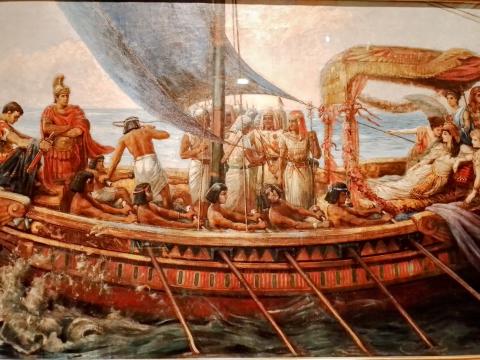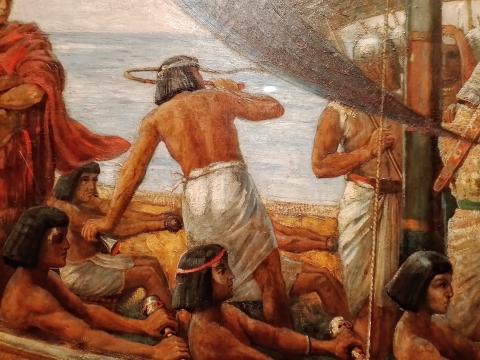The Flight of Antony and Cleopatra from the Battle of Actium (1897)

Agnes Pringle’s (1853-1954) The Flight of Antony and Cleopatra from the Battle of Actium (an 1897 oil on canvas) depicts the aftermath of the battle, with Antony and Cleopatra fleeing by boat following their defeat. The Laing Gallery’s curators rather patronisingly observe that:
'Cleopatra's pale-skinned appearance contrasts with that of the rowers, who Pringle assumed would have been enslaved people. Her imagining of the event does not fully consider or acknowledge the human suffering caused by slavery.
'…Agnes Pringle seems to have mistakenly assumed that the rowers would have been enslaved people, and shows an overseer with a whip. Victorian artists sometimes had a romanticised view of the past and did not fully acknowledge the suffering of servitude and slavery.
'…Paintings that depict enslaved people can be troubling and challenging to look at. What role should they play in a public museum like the Laing? We hope that this picture will prompt discussion and reflection about slavery.'

It was nineteenth-century Britain which led the world in the destruction of transatlantic slavery, as well as in East Africa and elsewhere. In contrast, courtesy of people smugglers and ill-policed immigration, there are more enslaved people operating in Britain than there has been for half a millennium (up to 130,000). I think that Miss Pringle and her generation have more of which to be proud than our smug, twenty-first century liberals who patronise the past but cannot see the hypocrisy and immorality at the end of their own noses.
- Log in to post comments


 Sunday Worship 10.45am & 6.00pm
Sunday Worship 10.45am & 6.00pm